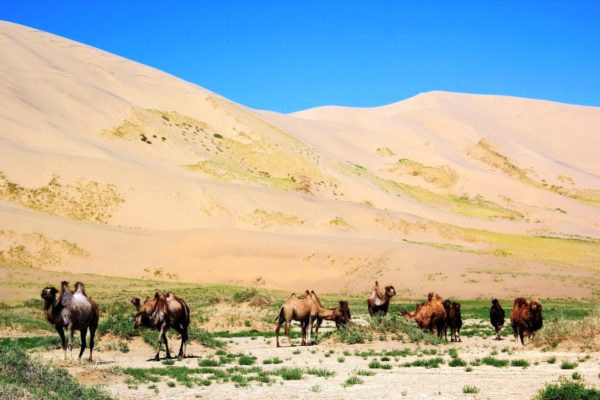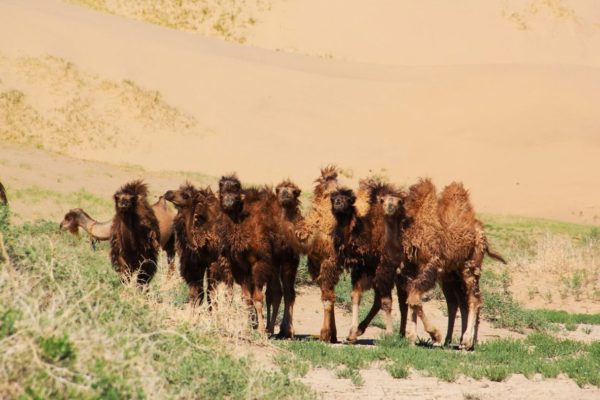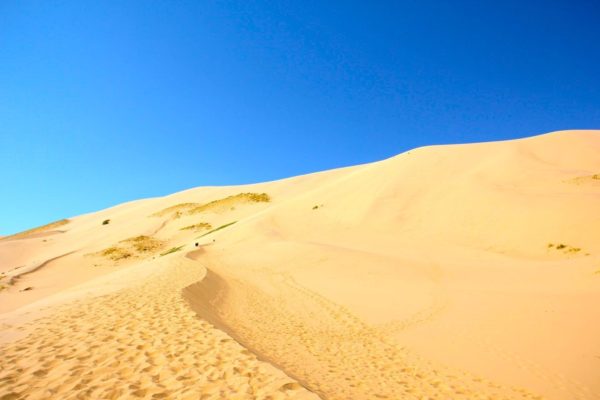The Khongor Sand Dunes, located in the Sevrei and Bayandalai soums of the Umnugovi province, is a vast sand dune stretching for approximately 180 kilometers behind the Sevrei and Zuulun ridges. The dunes span an area of 965 square kilometers and are oriented from northwest to southeast. The widest part of the sand, measuring 27 kilometers, is found in the northwestern region, while the narrowest point, measuring 800 meters, can be found in the central part. Upon reaching the top of the dunes, one can witness the beauty of hundreds of dunes scattered across the area.
Khongor Sand Dunes offers a unique view of the surrounding landscape with a rocky mountain located in front, a sand dune occupying the middle, and a green oasis with a river flowing in the north. The floodwaters from the Zuulun Mountains make their way through the sands of Khongor, seep into the soil, and form a spring called Seruun and Arganga at the northern end of the sands. The water then rises again from the ground and flows for more than 10 kilometers along the edge of the sands to the west, forming the Khongor River.
On windy days, sandstorms can obscure the surroundings, while on clear and sunny days, the sun shines in golden yellow, creating a spectacular natural display. Due to their slow migration, it is recommended to start from the nearest hill and follow the ridge from one peak to the next.
According to local elders, the reeds growing behind the sands of Khongor were so thick in the past that camels could not be found inside. The area also offers a unique experience, with the groundwater level at the foot of the dunes sometimes reaching high levels, allowing visitors to walk along a brook where lush green sprouts grow along the banks. Camels can often be seen grazing in the area, with the dunes shimmering in countless shades of yellow and red depending on the time of day. The unique colors of the desert, especially at sunset, provide an excellent photo opportunity, with the deep blue mountain range adding to the stunning contrast of colors.
Duut Mankhan (Singing Dune)
Duut Mankhan, the highest part of Khongor Sand Dune, provides visitors with an opportunity to experience the area’s unique features. Upon reaching the top of the dune, one can hear the sounds of nearby people, animals, and objects being carried by the wind. Looking down from the top, even cars on the ground appear to be tiny insects. Lying on the sand and looking up, one can hear the sound of an airplane taking off, creating the impression that an airplane will appear from somewhere. The sound of sand, heated by the sun and carried by the gentle wind, creates a melodic tune, earning the area its local name of “Duut Manhan.”
The area also features numerous petroglyphs on the rocks, with the depiction of a hunter with four horses chasing five ibex being a rare relic. Researchers suggest that the simple shape of the bow and arrow depicted in the petroglyphs could be from the Bronze Age.
Legend of Khongor Sand Dune
As per legend, the area has a historical significance, with the story of a domineering queen named Sevrei, known for her bad temper, being exiled to a distant place by her lord, who sought to tame her temper. Enraged, Queen Sevrei threw her mirror on her way to the distant location, guarded by soldiers, until it shattered into pieces and formed the Mirror Rock.
Every day, Queen Sevrei went to the riverbank in sadness, combing her long black tail and sitting in thought. Among the soldiers who came to watch, a hero named Sevrei fell in love with the queen’s sorrow. It is said that every stone on the way to the river of the beloved girl, the hero Khongor, softened every stone he stepped on and turned into a sand dune called Khongor.
The lord who missed his queen whom he had been accustomed to love despite her temperament would come to the Toli Khad/Mirror Rock/ to look at his queen’s face and later turned into a mountain called Noyon /Lord/ in front of the rock. Over the years, Toli Khad has faded to gray.
















